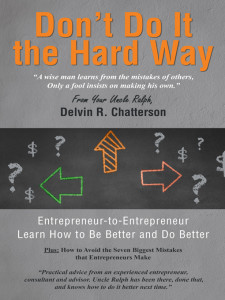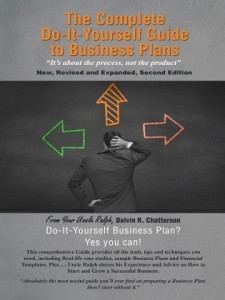Delvin R. Chatterson's Blog, page 12
July 7, 2016
Is your Bank a Welcome and Willing Partner in your Business?
This article is an extract from Uncle Ralph’s, “Don’t Do It the Hard Way” and the advice on managing your banking relationship is always relevant. Read the book.
Is your Bank a Welcome and Willing Partner in your Business?
If not, then you need to make changes.
 Entrepreneurs are usually quick to agree that banks are an obstacle to their success, rather than a key supporter. Most business owners certainly do not consider their bankers as welcome and willing partners in their business.
Entrepreneurs are usually quick to agree that banks are an obstacle to their success, rather than a key supporter. Most business owners certainly do not consider their bankers as welcome and willing partners in their business.
Yet it is an important relationship that will often affect your ability to grow and to survive periods of financial stress. It may very well be your most important strategic partnership. So give your banker the same priority and attention as your best customer. You do not want to have them become your worst supplier. If they are; then something needs to change.
Working with your bank as an unwilling and unwelcome partner can be a destructive distraction from managing business growth and profitability.
My recommendations for a more effective partnership with your banker are built on understanding the following key principles of that relationship:
1. They will not get it.
Start by accepting that your bankers will never fully understand what you do for a living – your motivation, your challenges or your circumstances. But you do have to try to get them to understand enough about you and your business operations so that they can be confident that working with you will be good for them.
Remember the bank’s primary role is not to lend you money; it’s to earn a return on their investment for their shareholders and limit the risk of losing money.
2. It’s only for the money.
You will need to prove that the money is all you need; because you have looked after everything else.
The banker does not want to worry about your customers, your management team, your sales and marketing efforts, your operating efficiencies, your health, your marriage or anything else except the financial services you need.
3. They have a checklist.
When you meet and fill in the forms, remember the banker wants to be satisfied on these five criteria:
Character – do you have a reputation of integrity and responsibility on prior financial obligations?
Capital – do you have enough invested in your business to be personally at risk?
Capacity – do you have good potential to support the cash flow requirements?
Collateral – if you cannot repay your loans, what assets are available to cover them?
Conditions – is your industry in good economic condition or in a downturn?
Good answers on these points will provide the start to a good relationship with a confident and willing partner instead of tentative support from a cautious and reluctant partner.
4. Reduce the risk.
You may be stimulated by risk and reward; your banker is not. Banking is a very conservative career choice. Regardless of how good you and your plans are, the banker will still want personal guarantees. That means he gets your house if you fail. (Note: I have never met a banker who found it amusing to suggest that you should get his house if you succeed.)
5. Think big.
The more you need, the more interested they’ll be and you’ll likely get better terms. (The only time I had no personal guarantees was when the loans were up to $4.8 million.) So, if you’re starting small, be sure to describe your growth plans and your intention to build a strong, long-term banking relationship.
6. Get a second opinion.
Bankers love to win business away from other banks. That is good for their careers. (That’s how we got the $4.8 million with favourable terms.) So check out the competition anytime you need new financing or your current bank is not serving you well.
Just be sincere and be ready to change. One banker asked me directly, “If I meet all your requests will you move to my bank?” I said, “Yes”. Then he delivered and so did we.
7. It’s not a people business.
It’s a numbers business and you cannot negotiate with a computer. That friendly, helpful person you’re talking to does not make the decisions. Your numbers get fed into some obscure computer program and the answers (or more questions) pop out. They are not negotiable. A good banking relationship means that you will be told what numbers are required to get favourable answers.
8. Manage your numbers
Make sure your business plan computes and gives financial results that are attractive to lenders. Then manage the numbers to deliver the results and stay within the limits set by the bank. Read the fine print to be sure you don’t miss any requirements to maintain financial ratios or any restrictions on payments to shareholders. Deliver financial reports as required, but also be sure to provide your own analysis and explanations before someone else does. You don’t want that computer to set off the alarms.
9. No surprises, please.
Bad news is never well received, but the reaction will be much worse if it’s also a surprise. And no news at all only makes them worry.
Keep your banker aware of what might go wrong and what you plan to do about it. Then keep them current as things evolve so they get used to your ever-changing circumstances and how you are handling them. (Hopefully, well.) Avoid going back with a new plan too soon or too often. And try to plan well ahead of any request for more financing. It is very hard to get the bank to help you out of a disaster when you’re in it.
10. People still matter.
The personal connection is still a very important part of a good relationship with your bank. Part of managing that relationship is to be sure that you are not entirely dependent on just one contact. If the relationship lasts, your contact person will change and you need to know someone else to maintain continuity of the relationship. Stay connected at several levels.
Your banking relationship needs to be strong to withstand the inevitable hard times that hit any business. A welcome and willing partner should help you weather those occasional storms.
I’m sure you have your own anecdotes of unsupportive bankers, but it is more important to get them onside with your other key strategic partners.
Happy banking!
Your Uncle Ralph, Del Chatterson
Read more at: Learning Entrepreneurship Blogs .
The Seven Biggest Mistakes and How to Avoid Them
Find the Exit before it’s an Emergency
When to Launch Your Business
The Four P’s of Salesmanship: “You wanna buy a book?”
Join our mailing list for more ideas, information and inspiration for entrepreneurs.
Click Here to check out Uncle Ralph’s books, “Don’t Do It the Hard Way” and “The Complete Do-It-Yourself Guide to Business Plans” Both are available online or at your favourite bookstore in hard cover, paperback or e-book.
The post Is your Bank a Welcome and Willing Partner in your Business? appeared first on Learning Entrepreneurship.
June 28, 2016
Brexit: Success for democracy or failure of leadership?
 Now we know the risk of a protest vote. You may accidentally get the result you were only intending as a threat to get some attention to your complaints. Poking the bear to make it go away may just provoke it into biting your hand off to leave it alone.
Now we know the risk of a protest vote. You may accidentally get the result you were only intending as a threat to get some attention to your complaints. Poking the bear to make it go away may just provoke it into biting your hand off to leave it alone.
What else have we learned?
Maybe asking for a final conclusion to a complicated issue in a simple referendum question is not a good idea. Delegating decision-making to a popular vote is a mistake, suggesting there is a simple solution to a wide range of complicated problems. “Just say yes, or no, and all your problems will go away.” Too many will make their decision for the wrong reasons, expecting the unlikely happy conclusions that they hope for and ignoring the negative consequences that cannot be avoided.
It is better to seek public consent on policy direction rather than asking for final conclusions. Surveys of voters already give us a good idea of their concerns and possible solutions that will be acceptable. Elected officials and public servants should be aware of voter sentiment and accept the responsibility to study the issues, assess the implications, make decisions and manage the consequences. The electorate will then decide which policy direction is preferred and whose performance deserves a renewed mandate at the next general election.
Plebiscites and referendums may seem like the ultimate expression of democracy, but they allow the angry and uninformed to be too easily misled and falsely motivated by populist rhetoric from those with a personal or political agenda that does not address the issues they are exploiting.
The most important lesson for leadership is to listen to all voices and not dismiss those who do not agree as ignorant, biased, fearful or unworthy of consideration. Unpersuaded to accept your arguments, they may turn to less desirable leadership and more drastic and painful solutions.
Democratic principles need to be respected, but leadership must also accept the responsibility to make difficult decisions and then communicate effectively that they are in the best long-term interest of the electorate. Accepting the appeal of simple short-term solutions can be disastrous.
Your Uncle Ralph, Del Chatterson
Read more at: Learning Entrepreneurship Blogs .
The Seven Biggest Mistakes and How to Avoid Them
Find the Exit before it’s an Emergency
When to Launch Your Business
The Four P’s of Salesmanship: “You wanna buy a book?”
Join our mailing list for more ideas, information and inspiration for entrepreneurs.
Click Here to check out Uncle Ralph’s books, “Don’t Do It the Hard Way” and “The Complete Do-It-Yourself Guide to Business Plans” Both are available online or at your favourite bookstore in hard cover, paperback or e-book.
The post Brexit: Success for democracy or failure of leadership? appeared first on Learning Entrepreneurship.
June 23, 2016
The Magic of Entrepreneurship
 What entrepreneurs do best is identify an opportunity and respond to it. They observe the market, test customer response, and then deliver what works at the right time and place.
What entrepreneurs do best is identify an opportunity and respond to it. They observe the market, test customer response, and then deliver what works at the right time and place.
In Rome this week, I noticed that the street vendors had almost all decided that the thousands of meandering tourists were most in need of either bottled water or a selfie-stick. Those were apparently the best-selling impulse items and they were offered everywhere. I did appreciate the water bottles during long tours of the ancient ruins in the hot sun, but was already hating the forest of selfie-sticks that were invading all my carefully composed souvenir photos and did not want to join in the contest of who could get their cell phone out in front of everyone else.
The street vendors’ sales strategy was simple and effective. A quick assessment of the passing prospects, a polite query then a quick decision to sell or move on to the next prospect. No time wasted on harassment or an obnoxious sales pitch. Pricing was competitive, one Euro for a bottle of water where the vendor was one of many and had a large stockpile and two Euros if he was alone in a remote corner with limited stock. The vendors also knew they were competing with free refills from available public drinking fountains, so they all sold branded, sealed bottled water that was ice cold.
But most impressive was their response to an unexpected thunderstorm and downpour chasing all the tourists under cover. Like magic, suddenly all the street vendors were offering small collapsible umbrellas and cheap plastic rain ponchos! Quality and price were not an issue, we needed them here and now, so sales were brisk for those that had them.
All good tactics for successful entrepreneurs. Whether you are a street vendor, a technology guru or a small business owner.
Be ready to respond to your market, rain or shine.
Your Uncle Ralph, Del Chatterson
Read more at: Learning Entrepreneurship Blogs .
The Seven Biggest Mistakes and How to Avoid Them
Find the Exit before it’s an Emergency
When to Launch Your Business
The Four P’s of Salesmanship: “You wanna buy a book?”
Join our mailing list for more ideas, information and inspiration for entrepreneurs.
Click Here to check out Uncle Ralph’s books, “Don’t Do It the Hard Way” and “The Complete Do-It-Yourself Guide to Business Plans” Both are available online or at your favourite bookstore in hard cover, paperback or e-book.
The post The Magic of Entrepreneurship appeared first on Learning Entrepreneurship.
June 3, 2016
Be Prudent not Paranoid
 Soon after starting my business in computer products distribution, I got burned by a couple of retailers passing bad checks. Whether they were dishonest or just bad managers, the result was the same: Whack, NSF!
Soon after starting my business in computer products distribution, I got burned by a couple of retailers passing bad checks. Whether they were dishonest or just bad managers, the result was the same: Whack, NSF!
I was still an inexperienced young entrepreneur, so it was easy to over-react and go beyond caution and become suspicious and distrustful of every customer. Not a good idea. I started to notice that the sales reps and customer service staff were following my lead too well. Aggressively pushing for cash-on-delivery or making unreasonable demands before accepting sales on credit.
Now we had a new problem. Customers were getting turned off and going elsewhere to competitors who were easier to do business with.
We adjusted our attitudes and went back to dealing in good faith and treating customers and other business partners with more respect. That means trusting them implicitly and expecting the best of intentions. Then if things ultimately go badly, we can still be friends and work it out.
It does not mean blind faith or being naïve. Prudent business practices are necessary and that includes clear terms and conditions on every sales order and purchase contract.
Be aware of the risks of doing business and then manage them.
Unfortunately, they cannot be avoided. Unless you lock the doors and don’t answer the phone.
Your Uncle Ralph, Del Chatterson
Read more at: Learning Entrepreneurship Blogs .
The Seven Biggest Mistakes and How to Avoid Them
Find the Exit before it’s an Emergency
When to Launch Your Business
The Four P’s of Salesmanship: “You wanna buy a book?”
Join our mailing list for more ideas, information and inspiration for entrepreneurs.
Click Here to check out Uncle Ralph’s books, “Don’t Do It the Hard Way” and “The Complete Do-It-Yourself Guide to Business Plans” Both are available online or at your favourite bookstore in hard cover, paperback or e-book.
The post Be Prudent not Paranoid appeared first on Learning Entrepreneurship.
Too Entrepreneurial, it’s not a good thing
This article is an extract from Uncle Ralph’s, “Don’t Do It the Hard Way.” Read the book.
 Too Entrepreneurial, i
t’s not a good thing
Too Entrepreneurial, i
t’s not a good thing
Brian was chairing again at the e2eForum meeting, but he had a look of concern; unusual for him, as he was normally confident and upbeat.
Gesturing to the flipchart, he said, “These are the issues that are starting to wear me down. Mostly because my two senior managers in sales and project management are starting to tell me I’m not entrepreneurial enough.”
We looked at his list of discussion points.
Too Entrepreneurial
Opportunistic
Optimistic
Impatient
Confident
Decisive
Creative
He added, “Uncle Ralph, when we were working together on my original business plan, you warned me about the risks of being too entrepreneurial. These are the points I remember and I thought we could discuss them today in the e2eForum.”
“But they all look good to me,” said Stan, “my father was always pushing me to do those things.”
“It all comes down to balance,” I said, “Balancing the entrepreneurial instincts and drive with the well thought-out strategic planning and analysis that help you make good decisions.”
“Let’s go through the list,” said Vivian, keeping us on the agenda.
I opened by explaining my perception that although certain characteristics of entrepreneurs are necessary for them to be successful; too entrepreneurial can be a problem for the business.
I went over the points that I had previously discussed with Brian while we worked on his business plan and he was bubbling with entrepreneurial enthusiasm. My intent was not to dampen his energy and enthusiasm, but to provide some perspective on the risks.
Too opportunistic
It can be hard to resist every potential sale or customer opportunity that is presented to you, but the successful entrepreneur builds the business by remaining focused on the strategic objectives and the agreed action plan to get there. Time and resources are easily wasted on chasing rainbows, if you are not sufficiently selective and insist on sticking to the plan.
Both current customers and new prospects will continuously presented unexpected opportunities. If they are asking for it, you should do it, right? Well, maybe not. Can you do it well? Profitably? Better than the available alternatives?
Your Go/No-Go decision should be based on two strategic requirements: leveraging your competitive strengths and building long term business value. Those are the two selection criteria that will keep you focused.
Too optimistic
It is important to be optimistic and think positively, but a little paranoia may be wise too. Remember the chairman of Intel, Andy Grove, titled his memoir Only the Paranoid Survive. Mark Zuckerberg has been credited with the same mentality in driving the astonishing growth of Facebook. Keep a wary eye on the market and monitor your business performance constantly. No news is not good news; you’re flying blindfolded. Don’t miss or ignore the warning signs of bumpy weather approaching.
Too impatient
Don’t expect too much too soon. It seems like everything takes longer than it should and most entrepreneurs have high expectations of themselves and their team. But don’t keep changing the plan or trying something new just because you’re not there yet. If you are making progress and the end goal is still valid, don’t give up too soon.
Too confident
Entrepreneurs usually have great confidence in their instincts and their intelligence. The mistake is to neglect or ignore market feedback and analysis of the facts. Also being action-oriented, the tendency is to react and ‘fire’ before the ‘ready, aim’ stages are complete. Painful surprises can result. Temper your self-confidence with a little humility – ask for help and get the input from others before you rush ahead.
Too decisive
Entrepreneurs are expected to be decisive and demonstrate leadership. But both can be overdone – deciding too quickly and providing too much direction so that employee input, initiative and creativity are stifled.
Often the decision does not need to be made quickly and the implementation will go more smoothly if time is taken to assess the feedback and answer the questions before commitments are made and the wheels are put in motion.
Back in the `80`s, Japanese management style was the model of success and one of their recognized tactics was to talk and talk and talk about the solution before implementing it. The result was much smoother and faster implementation than for the stereotypical macho decisive American manager who decides quickly and starts implementation without sufficient prior consultation with those affected.
Too creative
Many entrepreneurs are driven to ‘Do it my way’; that’s why they love running their own business. But sometimes alternatives have not even been considered and a better way exists. The creative solution may require improvising and learning on the fly, but maybe the best solution is sticking with what works, until it stops working.
Another mistake is staying too long with a solution and neglecting to evolve and grow by optimizing systems and processes and installing the best practices and latest technologies available in the industry. Not everything needs a creative new solution unique to your business. Maybe you’re not that special.
I summarized for the group. “Those were the points I had discussed with Brian and my assessment of the risks of being too entrepreneurial; all these mistakes can lead to serious difficulties for the business.”
Dave added, “It does help to keep in mind that some careful analysis and planning are important to offset the tendency to make decisions based on instinct and past experience. I’ve had to make some quick decisions recently that I’m now going back to and will take another look at.
“See you all in a month and we can talk about what changes we have made to avoid being too entrepreneurial.”
Your Uncle Ralph, Del Chatterson
Read more at: Learning Entrepreneurship Blogs .
The Seven Biggest Mistakes and How to Avoid Them
Find the Exit before it’s an Emergency
When to Launch Your Business
The Four P’s of Salesmanship: “You wanna buy a book?”
Join our mailing list for more ideas, information and inspiration for entrepreneurs.
Click Here to check out Uncle Ralph’s books, “Don’t Do It the Hard Way” and “The Complete Do-It-Yourself Guide to Business Plans” Both are available online or at your favourite bookstore in hard cover, paperback or e-book.
The post Too Entrepreneurial, it’s not a good thing appeared first on Learning Entrepreneurship.
June 2, 2016
Business is Like Golf
Easy to get into trouble and hard to get the results you want .
 It is the season again to get out and enjoy a round of golf. (Unless you’re one of those people who would rather eat sand than try to hit a golf ball straight for 400 yards and then roll it into a 4-inch cup.)
It is the season again to get out and enjoy a round of golf. (Unless you’re one of those people who would rather eat sand than try to hit a golf ball straight for 400 yards and then roll it into a 4-inch cup.)
It is a very simple and enjoyable game, or it’s a terrifyingly frustrating challenge that can drive you crazy. Again very much like business, you can love it and enjoy it or hate it and avoid it like a bad case of food poisoning.
You might think you are sufficiently smart and talented to succeed, but you may fail miserably in your attempts at both. There is value, therefore, in recognizing that you can learn from golf how to do better at business.
Have a strategic plan, master the fundamentals, and focus on execution
The first step is setting goals and having reasonable expectations. If your objective is to be a world class competitor, you will have to start early and work hard to develop the skills, knowledge and experience to win. In golf, that means swinging a club by age six, practising every day until you make the college team, then dropping all distractions, like a social life or a day job, and dedicating every effort to perfecting the skills and mental attitude to win against the best in the world.
If it’s already too late for that or you are not motivated to that degree, then adjust your expectations. Maybe you will be satisfied with occasionally breaking 100, or making par on the odd hole or even a rare birdie might be enough to keep you going.
As you play the game and watch the pros more often, you will also notice that it is important to have a strategy for each round and for each hole. Like in business, choosing a strategy is the same process of matching your strengths and competitive advantage to the opportunities that are presented, while avoiding the risks associated with your weaknesses.
Achieving good results requires having the right strategy, making good decisions, mastering the skills to deliver according to your plan, and then focusing on execution in spite of the stresses and distractions presented by the environment and the competition.
Sound familiar? Business is like golf and golf is like business. Don’t you agree?
But please remember to enjoy the golf, especially if your intent is to take a break from the challenges of your business. You do not need more stress created by unreasonable expectations. Arnold Palmer has been quoted as advising an angry amateur he was playing with, “You’re not good enough to get that upset by a bad shot.” Another good lesson from the world of golf.
Have a good day, occasionally hitting one long and straight.
Your Uncle Ralph, Del Chatterson

Read more articles like this one at: Business is Like Golf Blog
Friendly Competition Inspires Everybody
Stories behind the headlines
Match play: Beating one competitor at a time
Visit LearningEntrerpreneurship.com and join our mailing list for more ideas, information and inspiration for entrepreneurs.
Check out Uncle Ralph’s books, “Don’t Do It the Hard Way” and “The Complete Do-It-Yourself Guide to Business Plans” Available online or at your favourite bookstore in hard cover, paperback or e-book.
The post Business is Like Golf appeared first on Learning Entrepreneurship.
May 24, 2016
Simple is not always wrong
Maybe it’s not that complicated
 You have probably seen the frequent Tweets from both Abraham Lincoln and Albert Einstein claiming, “I never said half that crap you read on the Internet.”
You have probably seen the frequent Tweets from both Abraham Lincoln and Albert Einstein claiming, “I never said half that crap you read on the Internet.”
Well, even if Einstein never said it, I like his often quoted comment, “For every complicated problem there is an obvious, simple solution. That is wrong.”
But maybe he was wrong.
Sometimes the problem is that we make it more complicated than it needs to be. Maybe if we keep it simple, the solution is equally simple.
Just a thought.
Much as I am reluctant to argue with Einstein.
Please don’t Tweet him and get us started.
Your Uncle Ralph, Del Chatterson
Read more Learning Entrepreneurship Blogs .
Join our mailing list for more ideas, information and inspiration for entrepreneurs.
Click Here to check out Uncle Ralph’s books, “Don’t Do It the Hard Way” and “The Complete Do-It-Yourself Guide to Business Plans” Both are available online or at your favourite bookstore in hard cover, paperback or e-book.
The post Simple is not always wrong appeared first on Learning Entrepreneurship.
Some final Words from Uncle Ralph … on Business Plans
This article is an extract from Uncle Ralph’s, “The Complete Do-It-Yourself Guide to Business Plans”. Read the book.
Some final Words from Uncle Ralph … on Business Plans
Get the most out of the process.
Preparing a Business Plan will always force you to learn some things that you didn’t know  you needed to know and it will deliver some results that you hadn’t expected.
you needed to know and it will deliver some results that you hadn’t expected.
Most importantly, you will now have a document that has been shared and endorsed by your management team, your investors and your strategic partners and will serve as a performance management tool to achieve your business and personal objectives.
As a bonus, your title page will likely have a new corporate name, logo and marketing slogan that you developed for your business plan. Now you can incorporate them into your business cards, brochures, e-mail signature and stationery so that your business looks like it has already arrived.
You should also now have an “Elevator Pitch” and be comfortable using it: “Hello, this is who I am, what I do and why it matters to you.” You should be ready for any opportunity to promote your business with the 10-second version, the two minute version, the PowerPoint slide show, the YouTube video, the e-mail intro and the .pdf attachment.
You have probably enhanced your spreadsheet and financial analysis skills and have templates ready to assess any new changes in the industry or market landscape. And your future business expansion projects for new products or new markets.
And you’ve been promoted to “expert” if you, or anyone else, needs another Business Plan!
Re-Write for every Reader
Your plan needs to be written differently for different readers and different purposes. Not a substantially different plan obviously, just different emphasis and focus on what the particular reader will want to know and what you want from them.
Edit your Business Plan accordingly for each reader. It is also impressive if you personalize the cover page for each new audience.
Prior to approaching the banks or financial institutions, you should visit their websites to check their preferred business plan content and presentation. Verify if they have a particular business plan template or application form that is required. You may discover that up to a certain amount, say $100,000, they only accept applications online (avoiding wasting their time on small business clients). You may also discover that your personal financial statements and net worth are at least as important as your business plan. So get those in order and attach them to your plan.
Some readers of your plan may be more focused on your management credentials and experience; others on your marketing and sales plans to support the revenue forecasts.
Submission of your Executive Summary first will help you not only gauge their interest, but also determine which questions they will be seeking answers to.
There is never a Final Version
Your Business Plan is a working document that you should refer to regularly and review and revise annually. It was never intended for outsiders only or for one-time use only.
Of particular value for ongoing management of the business will be your financial goals, performance measures and the timetable in your Strategic Action Plan.
Continuing to monitor your progress against the plan is absolutely the best way to keep on track and achieve the objectives that you set for the business.
Remember the planning mantra: Review. Revise. Repeat.
That concludes my input and ideas for your Business Plan; the rest is up to you. Tuum est.
And good luck with your plans, that also helps.
Your Uncle Ralph, Del Chatterson
Read more Learning Entrepreneurship Blogs .
Join our mailing list for more ideas, information and inspiration for entrepreneurs.
Click Here to check out Uncle Ralph’s books, “Don’t Do It the Hard Way” and “The Complete Do-It-Yourself Guide to Business Plans” Both are available online or at your favourite bookstore in hard cover, paperback or e-book.
The post Some final Words from Uncle Ralph … on Business Plans appeared first on Learning Entrepreneurship.
May 23, 2016
The Best Advice I Ever Got
 This
Real Life Story
is an excerpt from
Uncle Ralph’s book
, “Don’t Do It the Hard Way.”
Read the book.
This
Real Life Story
is an excerpt from
Uncle Ralph’s book
, “Don’t Do It the Hard Way.”
Read the book.
Real Life Story: The Best Advice I Ever Got
In three words
This story should be shorter. Otherwise it appears to contradict the best advice I ever got.
However, I am choosing to reinforce the message and help make it more memorable by telling the story that goes with it (in keeping with the theme of this book). You may choose to read it for the same reasons.
It was at UBC in 1964, my first year in Engineering. All first-year engineers were given the Engineering Handbook providing all the advice and information we needed to successfully complete the following four years of study. The book was full of useful material and started with welcoming comments from the Dean of Engineering, the University President and other dignitaries – with all the usual flowery clichés expected in these publications.
One page was reserved for Steve Whitelaw, then President of the Engineering Undergraduate Society. Steve was a popular President with a reputation for bright, creative leadership. That reputation was partly based on his past leadership in a number of engineering student stunts that made the national news, like the time the engineers kidnapped another university’s mascot or hung a VW beetle from the Lion’s Gate Bridge. His biggest coup was bringing to a conclusion a long campus debate over some weird-looking concrete modern-art sculptures that appeared one-year on campus when we came back in September. The sculptures had received the scorn and contempt of ‘ignorant and uncultured’ engineering students, but were vigorously defended by arts students, their faculty and the administration.
The intensity of the debate exploded both on campus and in the local papers on the day the engineers went on a rampage and completely destroyed all the sculptures leaving them in heaps of broken concrete and steel. Then Steve announced that the engineers had built and installed them all in the first place.
So his advice in the Engineering Handbook would have received our attention. It was a blank page with his signature and the three words:
DON’T WASTE TIME
Call it leading by example.
Your Uncle Ralph, Del Chatterson
Read more at: Learning Entrepreneurship Blogs .
Forget Forecasts
The Seven Biggest Mistakes and How to Avoid Them
Find the Exit before it’s an Emergency
When to Launch Your Business
The Four P’s of Salesmanship: “You wanna buy a book?”
Join our mailing list for more ideas, information and inspiration for entrepreneurs.
Click Here to check out Uncle Ralph’s books, “Don’t Do It the Hard Way” and “The Complete Do-It-Yourself Guide to Business Plans” Both are available online or at your favourite bookstore in hard cover, paperback or e-book.
The post The Best Advice I Ever Got appeared first on Learning Entrepreneurship.
May 17, 2016
Recycle your Business Plan. Continuously
This article is an extract from Uncle Ralph’s, “The Complete Do-It-Yourself Guide to Business Plans”. Read the book.
Recycle your Business Plan . Continuously
 My constant theme in working with entrepreneurs on their Business Plans is “It’s about the process, not the product.” So what is the process? It’s continuous recycling, rethinking, reviewing and rewriting.
My constant theme in working with entrepreneurs on their Business Plans is “It’s about the process, not the product.” So what is the process? It’s continuous recycling, rethinking, reviewing and rewriting.
Most of the advice on preparing a Business Plan is very uninspiring: Unconvincing reasons for doing one and entirely discouraging in describing the elaborate process of documentation and financial analysis. Not likely to persuade busy, results-oriented, document-challenged entrepreneurs that it’s a good idea and that they can do it themselves.
So I started to describe my own approach as recycling your Business Plan. That best describes the process I recommend: Start with a very simple document, then continuously review, revise and expand the plan to deal with more issues and answer more questions.
I’m reminded of the “million dollar napkin” that one entrepreneur boasts he used to start his business simply by responding to the challenge to put it all on a restaurant napkin. And there are the thousands of successful businesses that were launched “on the back of an envelope“. It’s a good way to start your business plan – describe it in a few words on one page.
Here are the steps that I recommend to recycle your business plan. Each step is a version of your Business Plan that becomes more solid and detailed at each recycling:
Describe the market opportunity, your concept, business strategy, company name and marketing slogan and explain the reasons it will succeed – on one page (or napkin, or envelope).
Confirm that your personal objectives are consistent with your business objectives and that you have the all the skills, knowledge, experience and contacts required to get started (or explain how you will acquire them).
Collect and analyse data on your market, customers and competitors that confirm both the business opportunity and your ability to meet customer needs against competitive alternatives.
Do a business feasibility test at your estimated sales volumes, pricing and operating costs to determine profitability. Calculate the break-even sales level and compare it to your forecast sales.
Document in more detail your business concept and strategy and all the operating plans for facilities, organisation, operations, marketing and sales. Add a section on the risks considered and your planned response to anything that may not go according to plan.
Expand the financial analysis to include start-up costs, working capital required and the cash flow consequences to determine the financing required. How much, required when, and how will it be recovered? Test alternative scenarios to ensure that potential variations in sales forecasts and cost estimates will still lead to profitability and that financing will be adequate.
Complete the business plan document and a full set of financial projections against a checklist of the requirements for your intended audience – management team, lenders, investors, or strategic partners. Add relevant supporting appendices.
Then recycle the essential elements to capture your Business Plan in a two-to-three page Executive Summary, in a 2-minute elevator pitch, and in a 10-20 slide PowerPoint presentation for alternate forms of brief introduction to your plan.
The final recycling step for your Business Plan is to continuously refer to it against your future operating results. After review, check whether the plan and objectives are still valid and then revise either your plans or your performance to achieve the objectives.
That’s it.
These few simple steps will take you from a good idea to a well-developed and fully documented Business Plan that will serve as a guide to management and will persuade others to invest in your plan.
Remember the objective is to arrive at a useful communications document that confirms the business opportunity, describes your strategy and operating plans and presents the supporting research and financial projections to prove that it will be a profitable and successful business.
Recycling is good.
Your Uncle Ralph, Del Chatterson
Read more at: Learning Entrepreneurship Blogs .
The Seven Biggest Mistakes and How to Avoid Them
Find the Exit before it’s an Emergency
When to Launch Your Business
The Four P’s of Salesmanship: “You wanna buy a book?”
Join our mailing list for more ideas, information and inspiration for entrepreneurs.
Click Here to check out Uncle Ralph’s books, “Don’t Do It the Hard Way” and “The Complete Do-It-Yourself Guide to Business Plans” Both are available online or at your favourite bookstore in hard cover, paperback or e-book.
The post Recycle your Business Plan. Continuously appeared first on Learning Entrepreneurship.



